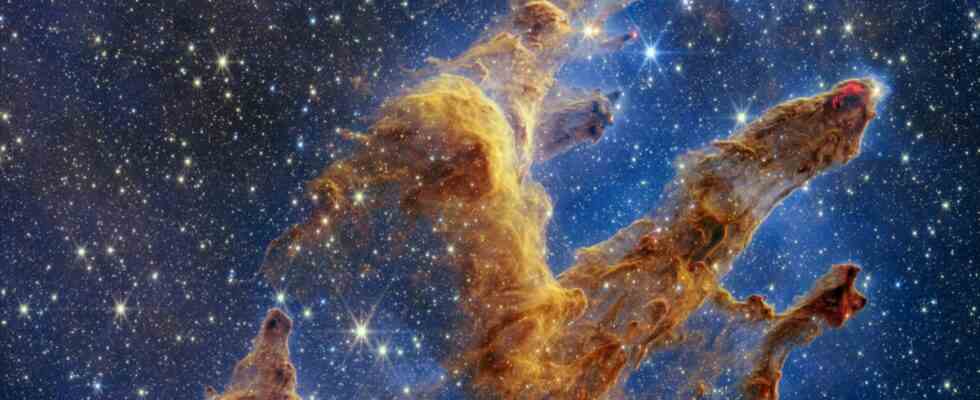“The deepest and sharpest infrared image to date of the distant universe”: With these words, NASA presented the first image taken by the “James Webb” space telescope, which cost ten billion euros. Many more have long since followed, and they amaze both professional and amateur astronomers. But what exactly do the recordings show? And is the excitement justified?
What can you see in the premiere picture?
Several bright white dots (not the ones with the star rays) can be seen in the center of the first “James Webb” exposure. This is the galaxy cluster SMACS 0723, as Ulrich Walter, Professor of Space Technology at the Technical University of Munich, explains. The light from this cluster traveled 4.6 billion years before it was received by James Webb.
SMACS 0723 acts like a lens that enlarges the light of far more distant galaxies and makes it visible. According to Walter, these can be seen in the picture as elongated orange spots arranged in a circle. “These galaxies have tiny, faint features never seen before, including stellar clusters and diffuse features,” writes Nasa.
Why are these galaxies so exciting?
After the Big Bang around 13.8 billion years ago, the universe consisted only of hydrogen and some helium, explains Walter. “The elements that make up most of us (carbon, oxygen, nitrogen) were bred in the stars of these first galaxies about 13 billion years ago.” They were thrown into our part of the universe by supernova explosions. Our solar system and our earth were formed there 4.5 billion years ago.
Are independent experts as enthusiastic as NASA?
Walter speaks of “very impressive pictures”. Stefan Dreizler, professor of astrophysics at the University of Göttingen, says: “There is no question that the ‘James Webb’ telescope will set new standards in many areas.”
What are the advantages of the telescope compared to the predecessor telescope “Hubble”?
According to Walter, “James Webb” delivers images with much better sharpness and also a larger visibility range. But there is also a disadvantage compared to Hubble. “Unfortunately, the ‘James Webb’ telescope, although about five times more expensive than Hubble, will only be able to work for about ten years.” Hubble has been active since 1992. Dreizler emphasizes that the new telescope is positioned far away from Earth. It will therefore observe more undisturbed and more efficiently than Hubble. “James Webb” will also be able to examine the atmospheres of planets from other stars. “It’s going to bring a lot of extremely exciting results that weren’t possible before.”
The telescope was very expensive. What does it have to deliver to count as a success?
Aerospace technology expert Walter answers with a counter question: “When is a telescope that costs around ten billion US dollars a success? When it does what it’s supposed to do! And it has proven that it can do it.” Now the telescope just has to “continue to deliver”. It is to be hoped that no systems fail. “Then a lot would be screwed up.” For Dreizler, the “James Webb” has already shown with the first picture that it also delivers the expectations of the achievable resolution.
The star continuously shows the most spectacular images from the Webb telescope.

